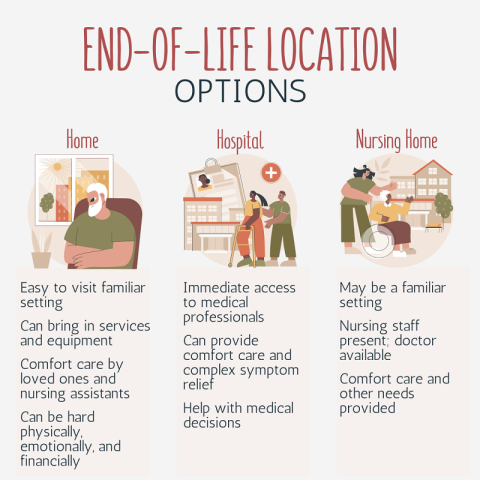Understanding End-of-Life Setting Options
At home
Home is where the heart is and where most people prefer to spend their final days. According to The Conversation Project, 70% of those surveyed want to die at home. In addition to being the most private setting, this option also allows family, friends, and others to visit easily and whenever the timing is best, which may provide comfort.
Services like hospice care, skilled nursing care and personal care (for example, for bathing or toileting) and special equipment like a hospital bed can usually be brought to the home setting. Other things to keep in mind when preparing or selecting end-of-life at home include:
- Work with the individual’s healthcare team to decide what kind of comfort or hospice care (symptom management and pain relief focused on quality of life) is appropriate. A doctor will oversee the health plan, even though nurses, aides, or family members may be administering the care, depending on what it involves.
- Providing end-of-life care at home can be hard physically, emotionally, and financially, particularly for loved ones providing the care. Paid caregivers and in-home providers can ease the pressure, but those services usually are not covered by private insurance, and Medicare imposes limits. However, most insurances, Medicare included, will cover many costs related to hospice care.
- If a person is coming home from the hospital for end-of-life care, a social worker or other discharge planner at the hospital may provide information about logistics, like locating needed services or equipment. An aging life care professional (geriatric care manager) or your local Area Agency on Aging may also have information on what is available in your area.
- Hospice organizations offer resources for spiritual care at this time. Spiritual leaders from a person’s faith community also offer comfort for the patient and family.
When home is not an option
Sometimes it is not possible or safe to send a person home for end-of-life care. In those cases, the options are the hospital or a nursing home or other care facility.
In hospitals
Many people spend the last years of their lives visiting medical centers and hospitals. The Centers for Disease Control and Prevention (CDC) reports that a little over 35% of people in the U.S. die in a hospital. When the hospital is the location at the end of life, remember:
- Immediate access to care by medical professionals who understand death and dying can be very reassuring, both for the patient and their family or friends.
- Some hospitals have palliative and hospice care teams who work with the regular care team to ensure comfort care is provided. They can offer complex symptom relief, as well as psychosocial and spiritual support. They can also help patients and families make medical decisions.
- Hospital chaplains can provide emotional and spiritual care, regardless of a patient’s religion or beliefs.
In nursing homes or other group living settings
Just under 30% of people die in a nursing home, long-term-care, or other facility based on CDC analysis. For example, some people are discharged from a hospital to a nursing home. These communities provide a wide range of services, including nursing services, meals and rehabilitation. If selecting a facility for end–of life care, keep in mind that:
Care staff are always present. A doctor may not be on site but available when needed. Also, a hospice team can work with facility staff to provide comfort care and spiritual support at the end of life.
Relationships with staff can make the care feel more personalized than in the hospital.
Put your wishes in writing
All settings for end-of-life care have benefits and challenges. The best course of action is to think about where you would want to be, include that in your advance care plan or advance directive, and share that information with your family and health care providers. That way, whatever the circumstances, those who care for and about you can honor your preferences as much as possible.
